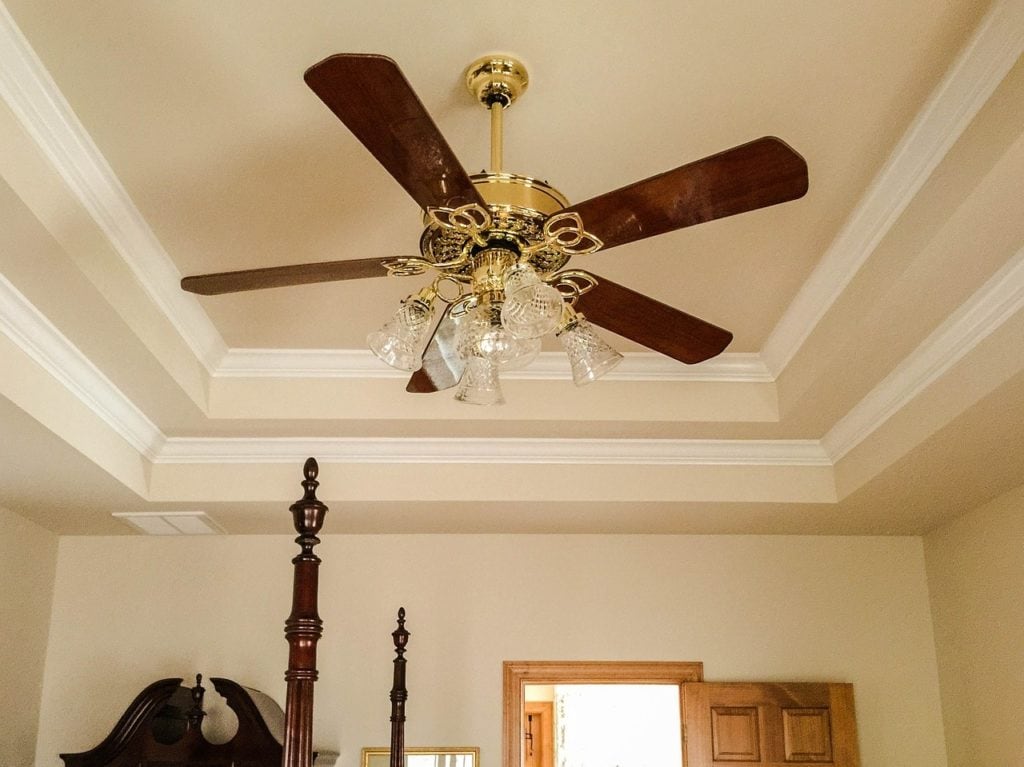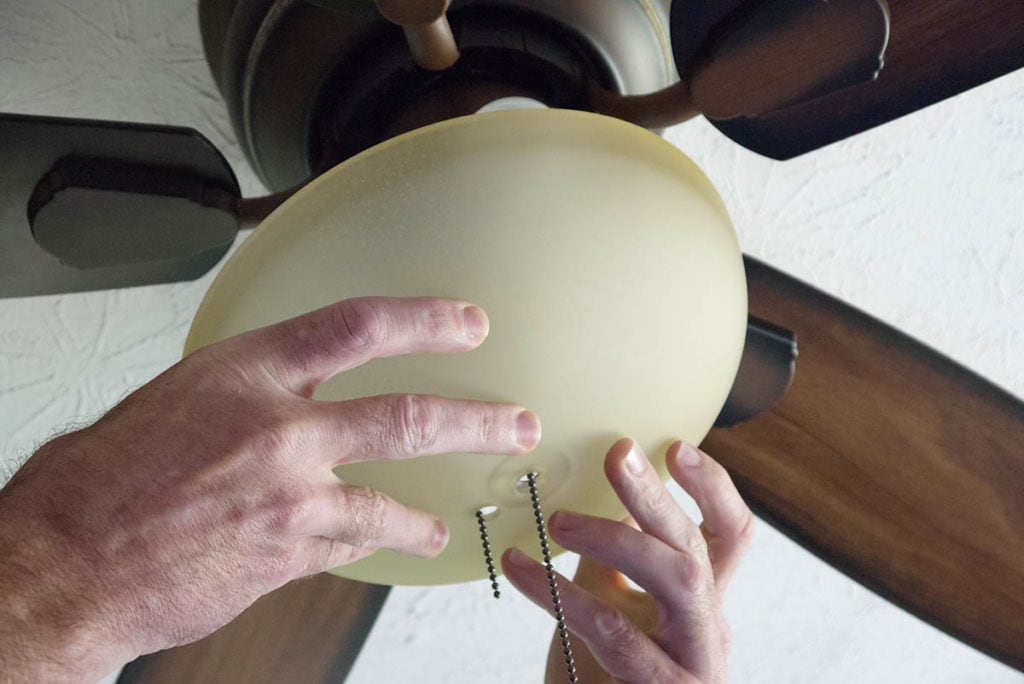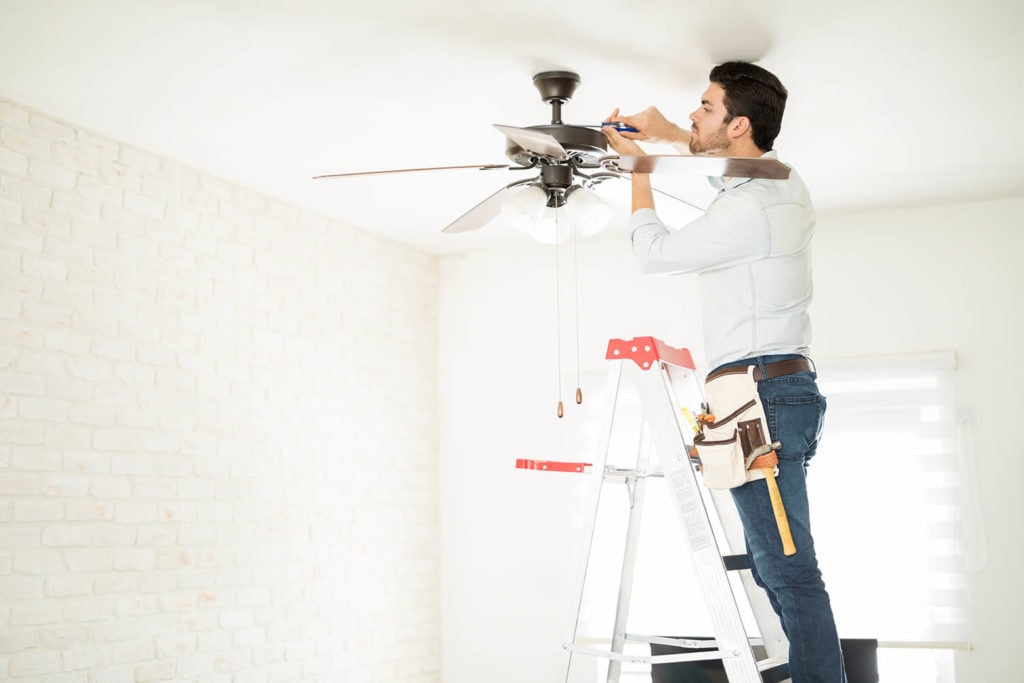How Much To Install A Ceiling Fan In 2025 Without Existing Wiring?
-
Codee Chessher
- Last updated:

Ceiling fans are one of the best ways to instantly add ventilation to a space without spending a ton on heating and cooling. In fact, a ceiling fan can supplement a home’s HVAC system by circulating air. Having one installed can be a significant challenge, though, especially if your home isn’t already wired for a ceiling fan.
So, how much does it cost to install a ceiling fan without the existing wiring? We’ll break down all the pricing here and give you an estimate of what you can expect to invest in this project. Let’s go!
How Do Ceiling Fans Help Air Conditioning?
Like all fans, ceiling fans work to make spaces cooler via the wind chill effect. When moving air circulates across and around your skin, it helps sweat evaporate at a higher rate, therefore lowering your body temperature incrementally.
The Department of Energy estimates1 that with a ceiling fan, you can raise the temperature of your air conditioner by about 4 degrees Fahrenheit and achieve the same cool feeling. This immediately saves you money on heating and cooling, which is a big contributor to electric bills. In fact, if you have a ceiling fan you may be able to eliminate using your air conditioner altogether in some areas, thereby increasing energy savings.
Ceiling fans are especially efficient at cooling spaces because they’re positioned at the top of a room. Unlike traditional fans, ceiling fans circulate the air from the top down, meaning they circulate more air. But they’re not just useful for the summer. By reversing the direction it spins in the winter, you can siphon cold air, which makes them useful in all seasons.

How Much Do Ceiling Fans Cost?
Ceiling fans range from small models without lights for $100-$150, whereas a ceiling fan with a regular pull chain light fixture will run between $150 to $300. For larger fans or fans made of stronger materials, you can find models that run $1,000 or more.
What affects ceiling fan prices:
- Material: steel and real wood are the most expensive, with high-end models reaching over $1,500.
- The number of blades: three-blade fans are typically the cheapest available, with most models ranging from $100 to $700. Five-blade fans produce more air with less noise, though higher-end models get as pricy as $1,000 or more.
- Style: there are regular, low-profile, rotational, directional, and more. Standard and low-profile start at about $100-150, while the others start at $150-200 and get as expensive as $800.
- Dry-rated or wet-rated: this refers to whether the fan is an ‘indoor’ or ‘outdoor’ fan. Outdoor fans are constructed with more weather-resistant components, and they start at $150. Indoor fans start a bit cheaper at $100, but both have a higher range of $1,200.
What’s the Cost to Install a Ceiling Fan Without Existing Wiring?

The cost of a ceiling fan depends on whether you already have the fan. If you do, you can save quite a bit on the installation. A handyman will charge between $50 to $80 an hour, not even counting the wiring or any other equipment involved. Let’s break down the costs to help you get a better understanding.
Ceiling Fan Installation Cost:
- Handyman labor: $50-80 (2-hour average)
- Electrician labor: $85-$100 per hour (2-hour average)
- Wiring: $6-$8 per foot
- Mount: $10 (if not included)
- Downrod: $5-$110
On average, you’re looking at between $400 to $800 to install a ceiling fan without existing wiring. This doesn’t include the cost of the ceiling fan itself, either.
Additional Costs To Anticipate
As with any home project, you can expect to pay more for your ceiling fan installation under certain circumstances. These are listed below for your convenience, so you can get an idea if these will apply to you.
Additional Costs May Include:
- Downrod: a downrod is a pipe that connects the fan to the motor housing and is most commonly used when you have a ceiling that’s 8 feet or taller. Downrods range from $5 for a 6-inch rod, while 72-inch downrods run as much as $100 or more.
- Wall & Ceiling Repairs: if the handyman and/or electrician needs to cut into walls, ceilings, or other areas, that will cost more for hourly labor and possibly materials like drywall.
- Additional wiring: If your home’s wiring is old, the electrician may run into unexpected problems that need to be fixed to install the ceiling fan, or they might find damaged or old wiring that needs to be replaced. This will cost you more on wiring and hourly labor.
- Location: urban areas tend to have higher hourly rates for jobs like this, whereas rural contractors typically charge less.
Do I Need An Electrician to Install a Ceiling Fan?

Yes! If you’re doing any kind of wiring in your home, you need to have a qualified electrician do the work for you. They’ll be aware of any permits that need to be filed as well as how to safely wire everything together. Electricians are expensive because they’re qualified to do the job right the first time.
Without an electrician, you’re just taking a handyman at his word that he’s able to properly wire the ceiling fan, junction box, and any other electric work that needs to be done. Because he’s probably not licensed either, any electrical work done by a handyman typically has no guarantee. If the fan falls out a week after installation or you have a house fire because of faulty wiring, you’re on the hook.
To be on the safe side, just hire a qualified and licensed electrician. You’ll pay more, yes, but the extra money is worth the peace of mind you have by knowing the work is guaranteed to be done correctly.
How To Take Care of Your Ceiling Fan
As with any machine, a ceiling fan requires maintenance to stay in the best possible condition. If it’s not taken care of, it may not work as well. Here are some handy tips you can use to keep your ceiling fan in great shape.
Related Read: How to Replace a Ceiling Fan in 9 Steps (with Pictures)
Ceiling Fan Tips:
- Regularly dust and clean the fan blades. As dust builds on the blades, they’re unable to circulate air as efficiently, so it feels like the fan isn’t working.
- Periodically tighten the screws on the fan. Ceiling fans vibrate a lot, and those vibrations can cause screws and other parts to come loose.
- Clean the fan motor from time to time. This sounds complicated, but the easiest method is to simply hold a vacuum hose to the slits on the side of the motor housing. It’ll suck up any dust and other debris that might be keeping the motor from running 100%.
 Conclusion
Conclusion
Ceiling fans are one of the best ways to stay cool without raising your electric bill by a ton, but they still cost a pretty penny to have installed. You can save some money by buying your own ceiling fan and downrod, but labor costs are the main factor.
Featured Image Credit: JamesDeMers, Pixabay
Contents
